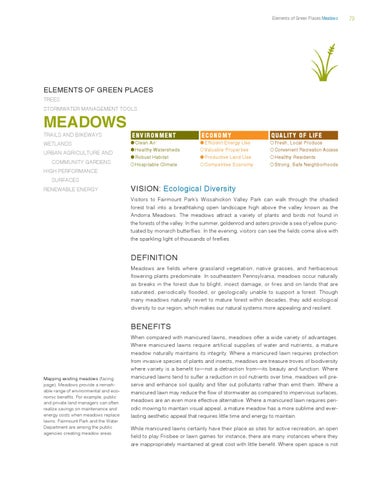Elements of Green Places Meadows
Elements of green places Trees Stormwater management tools
meadows trails and bikeways
Environment
economY
quality of life
wetlands
3 Clean Air 3 Healthy Watersheds 3 Robust Habitat 2 Hospitable Climate
3 Efficient Energy Use 2 Valuable Properties 3 Productive Land Use 2 Competitive Economy
2 Fresh, Local Produce 2 Convenient Recreation Access 2 Healthy Residents 2 Strong, Safe Neighborhoods
urban agriculture and community gardens high performance surfaces Renewable Energy
Vision: Ecological Diversity Visitors to Fairmount Park’s Wissahickon Valley Park can walk through the shaded forest trail into a breathtaking open landscape high above the valley known as the Andorra Meadows. The meadows attract a variety of plants and birds not found in the forests of the valley. In the summer, goldenrod and asters provide a sea of yellow punctuated by monarch butterflies. In the evening, visitors can see the fields come alive with the sparkling light of thousands of fireflies.
Definition Meadows are fields where grassland vegetation, native grasses, and herbaceous flowering plants predominate. In southeastern Pennsylvania, meadows occur naturally as breaks in the forest due to blight, insect damage, or fires and on lands that are saturated, periodically flooded, or geologically unable to support a forest. Though many meadows naturally revert to mature forest within decades, they add ecological diversity to our region, which makes our natural systems more appealing and resilient.
Benefits
Mapping existing meadows (facing page). Meadows provide a remarkable range of environmental and economic benefits. For example, public and private land managers can often realize savings on maintenance and energy costs when meadows replace lawns. Fairmount Park and the Water Department are among the public agencies creating meadow areas.
When compared with manicured lawns, meadows offer a wide variety of advantages. Where manicured lawns require artificial supplies of water and nutrients, a mature meadow naturally maintains its integrity. Where a manicured lawn requires protection from invasive species of plants and insects, meadows are treasure troves of biodiversity where variety is a benefit to—not a detraction from—its beauty and function. Where manicured lawns tend to suffer a reduction in soil nutrients over time, meadows will preserve and enhance soil quality and filter out pollutants rather than emit them. Where a manicured lawn may reduce the flow of stormwater as compared to impervious surfaces, meadows are an even more effective alternative. Where a manicured lawn requires periodic mowing to maintain visual appeal, a mature meadow has a more sublime and everlasting aesthetic appeal that requires little time and energy to maintain. While manicured lawns certainly have their place as sites for active recreation, an open field to play Frisbee or lawn games for instance, there are many instances where they are inappropriately maintained at great cost with little benefit. Where open space is not
79
